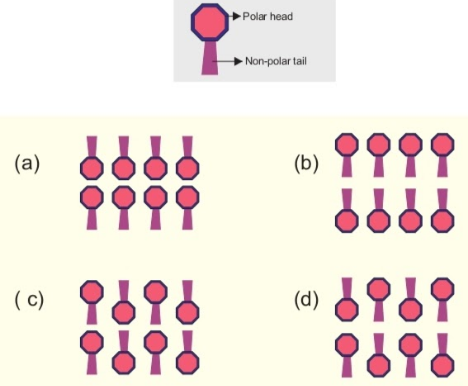
The lipid molecules present in plasma membranes have polar heads and nonpolar tails (as shown in the figure).
Which option represents the correct arrangement of lipids in a lipid bilayer?


Answer
439.8k+ views
Hint: The main component of a plasma membrane are lipids which include phospholipids and cholesterol. Lipid is made of glycerol, a phosphate-linked head group with two fatty acid tails.
Complete answer:
The correct arrangement of lipids in lipid bilayer is:

Lipids are amphipathic i.e. they have two ends: hydrophilic (water-loving) and hydrophobic (water-repelling). This amphipathic nature causes them to form bilayers. Lipid bilayer has one of the most important characteristics which is the fluidity which is very crucial for the membrane. Lipids contain fats, phospholipids and steroids. Fats give energy storage, phospholipid play a vital role in the formation of the cell membrane and steroids allow the chemical functioning of the cell and are also responsible for the structural functioning.
The arrangement of the molecules is in a way that the hydrophilic region is extracellular in the form of a polar head whereas the hydrophobic region is intracellular in the form of a nonpolar tail. The hydrophobic part contains two tails of fatty acids which are present at the centre of the membrane. The fatty acids in the membrane are unsaturated as it makes it easy for the membrane to allow certain molecules. The lipid bilayer is penetrated by the intrinsic proteins which bind them tightly. These are made up of phospholipids and cholesterol.
So, the correct answer is option (b).

Note:
Lipids give the whole world energy as they are buried deep under the ground in the form of oil which produces energy. Lipid is a fat molecule which constitutes almost 50 per cent of the human cell. Lipids are the most important component to build the cell membrane. Lipids show a major role in various illnesses like Alzheimer's disease, cancer, asthma, rheumatoid, arthritis and several inflammatory diseases.
Complete answer:
The correct arrangement of lipids in lipid bilayer is:

Lipids are amphipathic i.e. they have two ends: hydrophilic (water-loving) and hydrophobic (water-repelling). This amphipathic nature causes them to form bilayers. Lipid bilayer has one of the most important characteristics which is the fluidity which is very crucial for the membrane. Lipids contain fats, phospholipids and steroids. Fats give energy storage, phospholipid play a vital role in the formation of the cell membrane and steroids allow the chemical functioning of the cell and are also responsible for the structural functioning.
The arrangement of the molecules is in a way that the hydrophilic region is extracellular in the form of a polar head whereas the hydrophobic region is intracellular in the form of a nonpolar tail. The hydrophobic part contains two tails of fatty acids which are present at the centre of the membrane. The fatty acids in the membrane are unsaturated as it makes it easy for the membrane to allow certain molecules. The lipid bilayer is penetrated by the intrinsic proteins which bind them tightly. These are made up of phospholipids and cholesterol.
So, the correct answer is option (b).

Note:
Lipids give the whole world energy as they are buried deep under the ground in the form of oil which produces energy. Lipid is a fat molecule which constitutes almost 50 per cent of the human cell. Lipids are the most important component to build the cell membrane. Lipids show a major role in various illnesses like Alzheimer's disease, cancer, asthma, rheumatoid, arthritis and several inflammatory diseases.
Recently Updated Pages
The correct geometry and hybridization for XeF4 are class 11 chemistry CBSE

Water softening by Clarks process uses ACalcium bicarbonate class 11 chemistry CBSE

With reference to graphite and diamond which of the class 11 chemistry CBSE

A certain household has consumed 250 units of energy class 11 physics CBSE

The lightest metal known is A beryllium B lithium C class 11 chemistry CBSE

What is the formula mass of the iodine molecule class 11 chemistry CBSE

Trending doubts
Why was the Vernacular Press Act passed by British class 11 social science CBSE

Arrange Water ethanol and phenol in increasing order class 11 chemistry CBSE

Name the nuclear plant located in Uttar Pradesh class 11 social science CBSE

One Metric ton is equal to kg A 10000 B 1000 C 100 class 11 physics CBSE

What steps did the French revolutionaries take to create class 11 social science CBSE

How did silk routes link the world Explain with three class 11 social science CBSE




